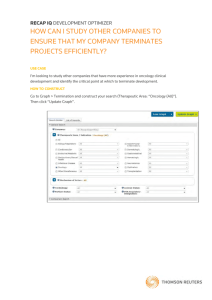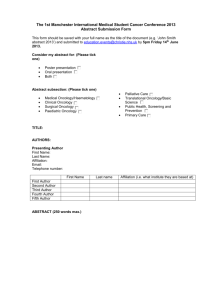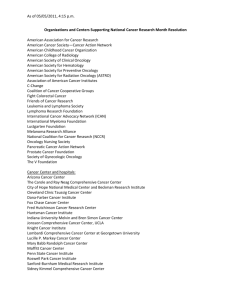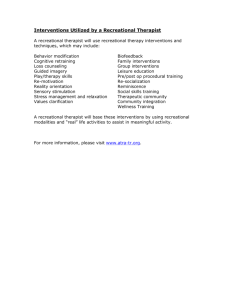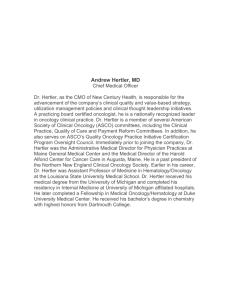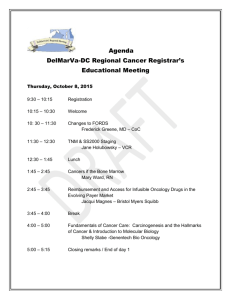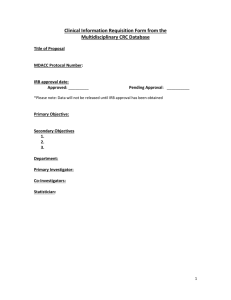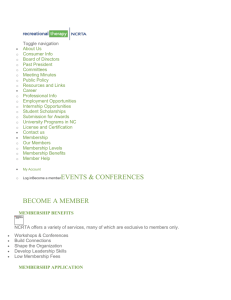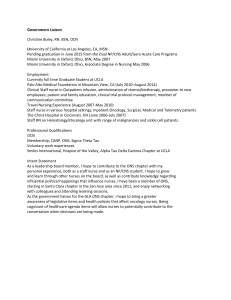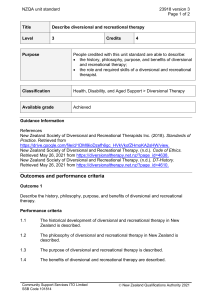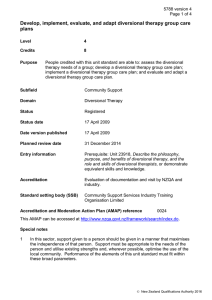Diversional activity deficit - the European Oncology Nursing Society
advertisement
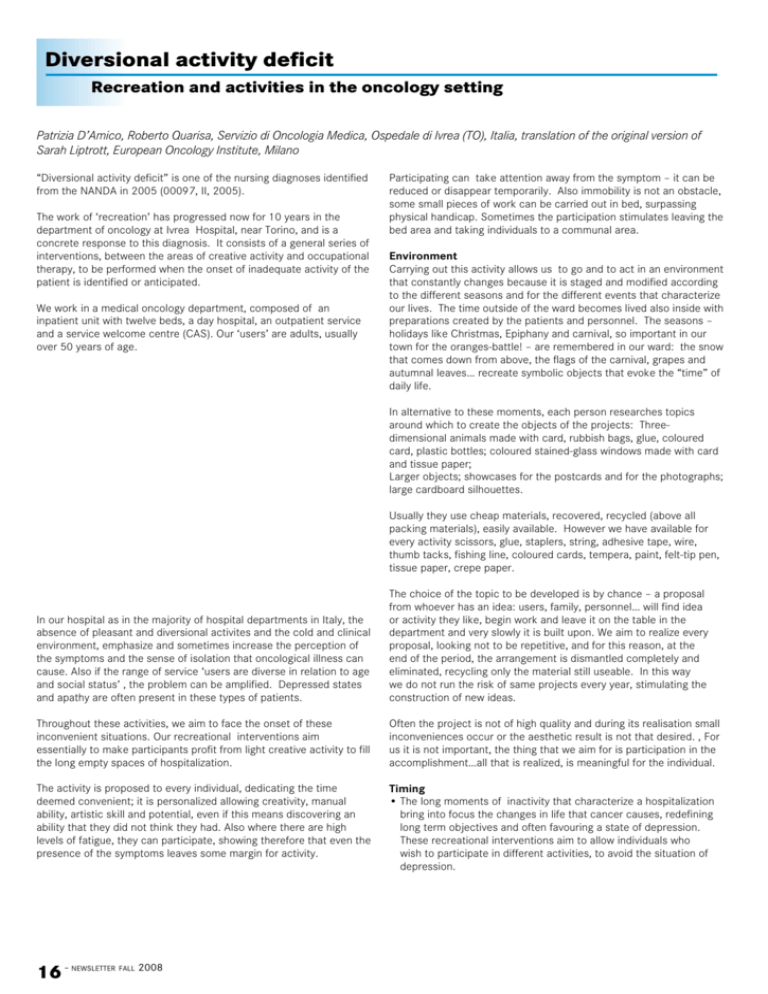
Diversional activity deficit Recreation and activities in the oncology setting Patrizia D’Amico, Roberto Quarisa, Servizio di Oncologia Medica, Ospedale di Ivrea (TO), Italia, translation of the original version of Sarah Liptrott, European Oncology Institute, Milano “Diversional activity deficit” is one of the nursing diagnoses identified from the NANDA in 2005 (00097, II, 2005). The work of ‘recreation’ has progressed now for 10 years in the department of oncology at Ivrea Hospital, near Torino, and is a concrete response to this diagnosis. It consists of a general series of interventions, between the areas of creative activity and occupational therapy, to be performed when the onset of inadequate activity of the patient is identified or anticipated. We work in a medical oncology department, composed of an inpatient unit with twelve beds, a day hospital, an outpatient service and a service welcome centre (CAS). Our ‘users’ are adults, usually over 50 years of age. Participating can take attention away from the symptom – it can be reduced or disappear temporarily. Also immobility is not an obstacle, some small pieces of work can be carried out in bed, surpassing physical handicap. Sometimes the participation stimulates leaving the bed area and taking individuals to a communal area. Environment Carrying out this activity allows us to go and to act in an environment that constantly changes because it is staged and modified according to the different seasons and for the different events that characterize our lives. The time outside of the ward becomes lived also inside with preparations created by the patients and personnel. The seasons – holidays like Christmas, Epiphany and carnival, so important in our town for the oranges-battle! – are remembered in our ward: the snow that comes down from above, the flags of the carnival, grapes and autumnal leaves… recreate symbolic objects that evoke the “time” of daily life. In alternative to these moments, each person researches topics around which to create the objects of the projects: Threedimensional animals made with card, rubbish bags, glue, coloured card, plastic bottles; coloured stained-glass windows made with card and tissue paper; Larger objects; showcases for the postcards and for the photographs; large cardboard silhouettes. Usually they use cheap materials, recovered, recycled (above all packing materials), easily available. However we have available for every activity scissors, glue, staplers, string, adhesive tape, wire, thumb tacks, fishing line, coloured cards, tempera, paint, felt-tip pen, tissue paper, crepe paper. In our hospital as in the majority of hospital departments in Italy, the absence of pleasant and diversional activites and the cold and clinical environment, emphasize and sometimes increase the perception of the symptoms and the sense of isolation that oncological illness can cause. Also if the range of service ‘users are diverse in relation to age and social status’ , the problem can be amplified. Depressed states and apathy are often present in these types of patients. The choice of the topic to be developed is by chance – a proposal from whoever has an idea: users, family, personnel… will find idea or activity they like, begin work and leave it on the table in the department and very slowly it is built upon. We aim to realize every proposal, looking not to be repetitive, and for this reason, at the end of the period, the arrangement is dismantled completely and eliminated, recycling only the material still useable. In this way we do not run the risk of same projects every year, stimulating the construction of new ideas. Throughout these activities, we aim to face the onset of these inconvenient situations. Our recreational interventions aim essentially to make participants profit from light creative activity to fill the long empty spaces of hospitalization. Often the project is not of high quality and during its realisation small inconveniences occur or the aesthetic result is not that desired. , For us it is not important, the thing that we aim for is participation in the accomplishment…all that is realized, is meaningful for the individual. The activity is proposed to every individual, dedicating the time deemed convenient; it is personalized allowing creativity, manual ability, artistic skill and potential, even if this means discovering an ability that they did not think they had. Also where there are high levels of fatigue, they can participate, showing therefore that even the presence of the symptoms leaves some margin for activity. Timing •The long moments of inactivity that characterize a hospitalization bring into focus the changes in life that cancer causes, redefining long term objectives and often favouring a state of depression. These recreational interventions aim to allow individuals who wish to participate in different activities, to avoid the situation of depression. 16 - newsletter fall 2008 This happens not only with the creation of projects, but also with different interventions that involve the user in social games, the accomplishment of a puzzle, reading of a book chosen from the many available in the library. There are then moments of fun in which to assist like onlookers listening to some songs, musical groups or watching entertainment shows. Atmosphere The structural interventions are aimed to be more welcoming to the environment, the work of collaboration between personnel and users for the accomplishment of the projects, participation as simple onlookers to the events: are all elements that contribute to change the “atmosphere”. The climate is defined as an integration between physical environment and social aspects, relations and emotions that characterize an organization. Our intention is to create a family atmosphere, warm and attentive to the human dimension in providing a positive quality care environment.. Sometimes during the recreational activity, nurses, patients and carers find themselves around a table together, which breaks down the professional/institutional structure and allows a more human dimension providing exchange and ‘chatting’ to know more personal aspects, taste, episodes of life not usually recalled in normal hospital interactions. It is these “chats”, exchanged in friendship, that often help to establish answers to inexplicable reactions, reveal family dynamics, unexpressed fears, elements that become a valid help for our activity, and that allow better individualised care. The participation in recreational activity otherwise allows different users to know, or to be familiar with them, to go out from their rooms and to share with the others…. This recreation often takes place also with the family, for them this represents a diversion that allows temporary removal of the attention of worries bound to the illness of the person for whom they care. The project started in 1997, driven by the corporate training center and aimed at students participation. The initial stages included some nurses and the activity was aimed at group-work and playing rediscovery . The project was then managed totally by nurses in the general medicine department and successively in oncology, and from the start it has been self-financed. The time dedicated is almost entirely within normal working hours, due to diversional activity being developed concomitantly with the activity in the department. Within the Italian Oncology Nurses Association (AIIO), a study group named Grano (oncology recreation group) established in 2004 collected information about the Italian reality of the development of existing light, artistic, and recreational activities. One of the first objectives of the group was to map within Italy the consistency of the diversional activity in non-paediatric oncology departments. This enquiry has emphasized the scarce attention to this problem and the scarce interest, maybe correlated to a lack of knowledge in this subject that this aspect of humanisation and related activity are covered in the nursing profession. The AIIO National Congresses of and other educational courses have been organized with the objective of conveying theory and techniques of recreational interventions to make nurses aware of these less ‘scientific’ aspects of care, but that are equally important for our activity. After these episodes of training/education, the reality has begun to dawn on their services. To increase further the circulation of the awareness of the diversional techniques, they have been put onto the AIIO website – a space that collects the blog of some services. Besides documenting activity carried out, the blog constitutes a cue for those who want to begin to enliven the actual working reality. The site AIIO is found at: htpp://www.aiio.it The carrying out of recreational activity has been valid help to improve the work of the team, all the activities are carried out thanks to the support of the health care professionals. newsletter fall 2008 - 17
